 Open to the public, Bryn Celli Ddu is a Neolithic passage grave of the European Atlantic tradition.
Probably built c.3500 BC it contained inhumations in a cruciform chamber that was covered by a large cairn and set inside a circular ditch.
The chamber (now supported by concrete beams) is unusual in containing a pillar stone [Pic].
The mound was rebuilt after the 1928 excavation but is considerably smaller than it was, now only covering the passage rather than the whole circle.
An area of quartz pebbles and hearths was found just outside the entrance, with an ox burial in a three sided shelter just outside that again.
Open to the public, Bryn Celli Ddu is a Neolithic passage grave of the European Atlantic tradition.
Probably built c.3500 BC it contained inhumations in a cruciform chamber that was covered by a large cairn and set inside a circular ditch.
The chamber (now supported by concrete beams) is unusual in containing a pillar stone [Pic].
The mound was rebuilt after the 1928 excavation but is considerably smaller than it was, now only covering the passage rather than the whole circle.
An area of quartz pebbles and hearths was found just outside the entrance, with an ox burial in a three sided shelter just outside that again.
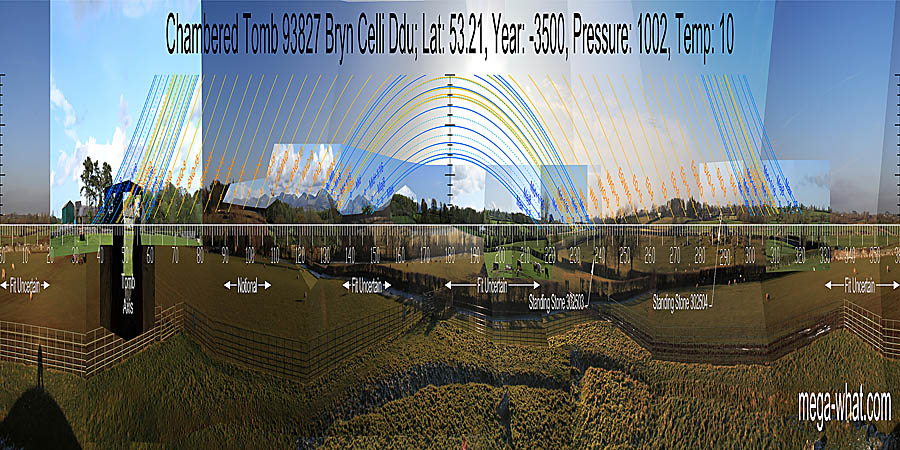 Located in the Llanddaniel Fab area of Anglesey, the Bryn Celli Ddu tomb features a passage aligned to summer solstice sunrise.
Winter solstice sunrise would have been at a key point on the mountains of Snowdonia but there are now trees obscuring both these events.
Located in the Llanddaniel Fab area of Anglesey, the Bryn Celli Ddu tomb features a passage aligned to summer solstice sunrise.
Winter solstice sunrise would have been at a key point on the mountains of Snowdonia but there are now trees obscuring both these events.
South appears to be at the intersect between distant mountains and nearer ground [Pic].
North is in a slight dip within a wider dip [Pic].
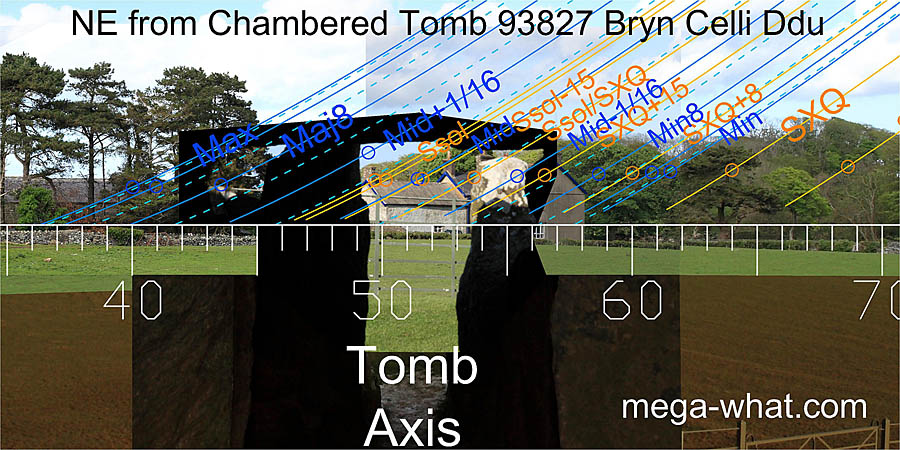 The passage is oriented in the general direction of mid-summer sunrises and lunar mid-cycle but just what the true horizon profile should be remains unknown.
Click here for a picture looking down the passage from the chamber.
The passage is oriented in the general direction of mid-summer sunrises and lunar mid-cycle but just what the true horizon profile should be remains unknown.
Click here for a picture looking down the passage from the chamber.
Most of the horizon was surveyed from just behind the chamber but, because of the mound, the north-east was done from just outside the passage entrance.
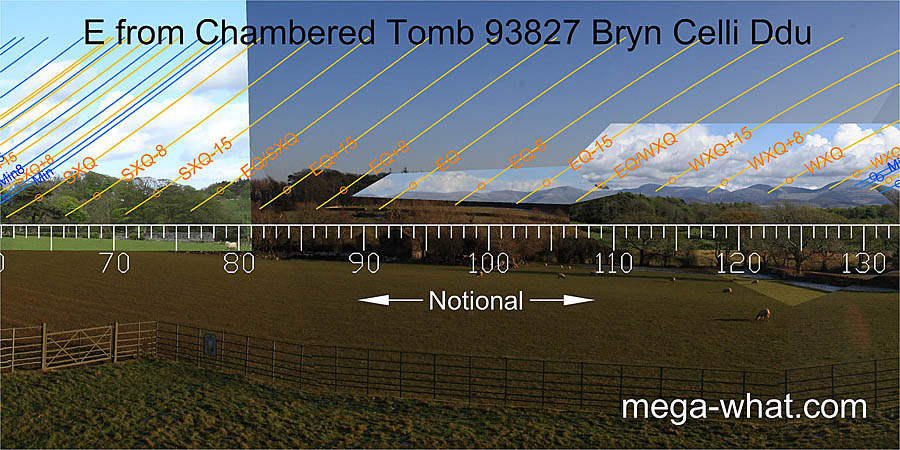 The majority of the eastern horizon is obscured by trees.
There should probably be a view of the mountains of Snowdonia and the likely profile has been inset but it is currently impossible to be sure of the true profile.
The mountains were photographed from higher ground to the north-west.
The majority of the eastern horizon is obscured by trees.
There should probably be a view of the mountains of Snowdonia and the likely profile has been inset but it is currently impossible to be sure of the true profile.
The mountains were photographed from higher ground to the north-west.
 Fortunately, a small portion of the mountains may be seen through a gap in the trees to the south-east.
There is an obvious good fit here with WXQ-8, the quarter-month south of the cross-quarter, and the minor standstill on the left and right hand tops of the highest mountain.
The solstitial half-month bracket is at the top of a steep drop and then the view obscured by trees has been inset again.
The fit shouldn't be too bad this time as the next surveyable mountain top was only 31° further south.
Fortunately, a small portion of the mountains may be seen through a gap in the trees to the south-east.
There is an obvious good fit here with WXQ-8, the quarter-month south of the cross-quarter, and the minor standstill on the left and right hand tops of the highest mountain.
The solstitial half-month bracket is at the top of a steep drop and then the view obscured by trees has been inset again.
The fit shouldn't be too bad this time as the next surveyable mountain top was only 31° further south.
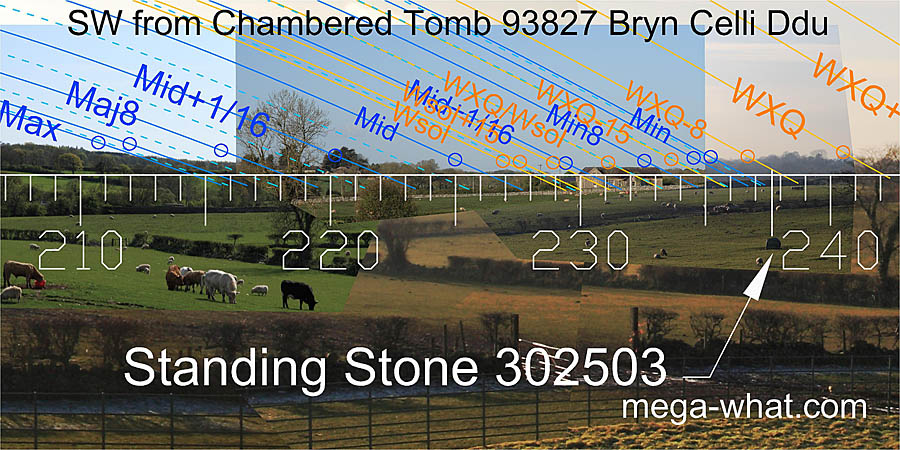 The entire south-west horizon is masked by trees though it seems to form a wide dip with the solstice somewhere near the lowest point.
About 150m away is a sub-rectangular stone 1.9m wide, 0.4m thick and 1.3m high.
This stone (NPRN:302503) was recorded in 1937 but does not appear on early OS editions (1889-1917) and thus may possibly have been placed between 1917 & 1937 unlikely though that is.
WXQ-8, the quarter-month south of the cross-quarter, features again.
The entire south-west horizon is masked by trees though it seems to form a wide dip with the solstice somewhere near the lowest point.
About 150m away is a sub-rectangular stone 1.9m wide, 0.4m thick and 1.3m high.
This stone (NPRN:302503) was recorded in 1937 but does not appear on early OS editions (1889-1917) and thus may possibly have been placed between 1917 & 1937 unlikely though that is.
WXQ-8, the quarter-month south of the cross-quarter, features again.
 To the west, the slope appears to rise to a high point in the vicinity of the equinox before turning into a ridge. Once more, the true profile is masked by trees and buildings.
To the west, the slope appears to rise to a high point in the vicinity of the equinox before turning into a ridge. Once more, the true profile is masked by trees and buildings.
A 3.3m tall Standing Stone (NPRN:302504) is visible about 500m away to the WNW. This stone was also first recorded in 1937 and did not appear on earlier OS maps. It seems to indicate a half-month off the cross-quarter rather than the quarter-month.
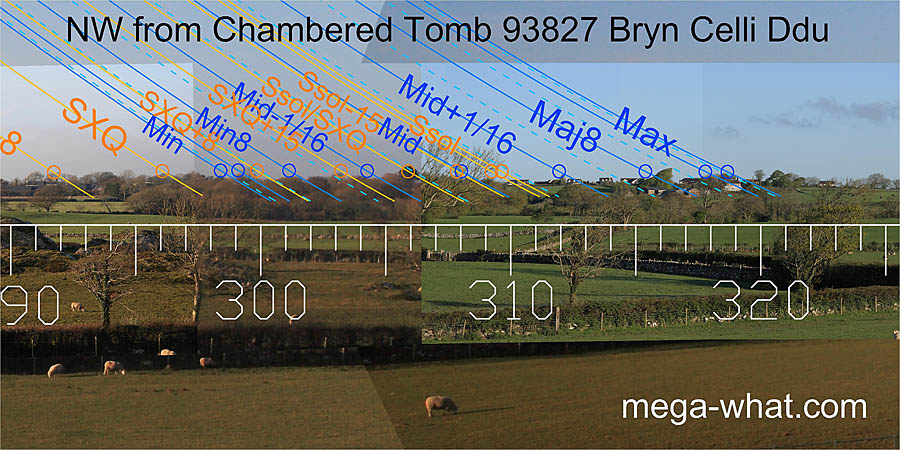 Further to the north-west the trees peter out but buildings replace them. Some points on this local ridge were surveyed from both chamber and entrance.
They show that it this part of the horizon is close enough for the azimuth of any feature to vary by as much as 3/4° though the effect on declination is considerably less.
Further to the north-west the trees peter out but buildings replace them. Some points on this local ridge were surveyed from both chamber and entrance.
They show that it this part of the horizon is close enough for the azimuth of any feature to vary by as much as 3/4° though the effect on declination is considerably less.
There are many prehistoric tombs in the U.K. but the only other surveyed ones are:
- Carn Besi Chambered Tomb in Carmarthenshire.
- Stoney Littleton Long Barrow in Somerset.
References / Links
